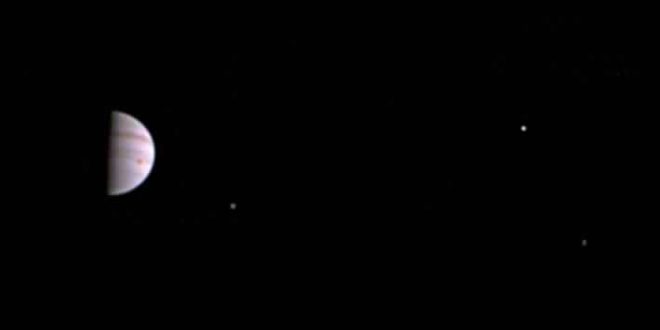NASA’s Juno mission to Jupiter has sent back its first picture of the planet since going into orbit around it last week. The image shows a section of the gas giant, along with three of its 67 moons: Io, Europa and Ganymede.
The image was taken on July 10 at 10:30 am PDT. It was the first image captured after the spacecraft’s JunoCam was reactivated after being taken offline four days before arrival to conserve battery power for the 35-minute engine burn that placed Juno into orbit around Jupiter and was taken from a distance of 2.7 million mi (4.3 million km) from the planet.
Juno is currently in a temporary 53.5-day orbit that will carry it over Jupiter’s poles. Another course correction burn in October will place it in highly eccentric 14-day orbit that will bring it within 2,600 mi (4,100 km) of the cloud tops and below the deadly bands of radiation that encircle the planet. From here the probe will study Jupiter’s origins, structure, atmosphere, aurorae, and magnetosphere.
NASA says that this initial image indicates that Juno has survived its first close encounter with Jupiter without the local radiation degrading its systems. The first high-resolution images are scheduled to be taken on August 27 during Juno’s next close pass.
Despite its ability to send back the highest resolution images yet of Jupiter, NASA does not regard JunoCam as a scientific instrument. Its primary purpose is to encourage public participation in the mission, though the pictures may be of use to scientists.
Success! Engine burn complete. #Juno is now orbiting #Jupiter, poised to unlock the planet's secrets. https://t.co/YFsOJ9YYb5
— NASA (@NASA) July 5, 2016
Agencies/Canadajournal
 Canada Journal – News of the World Articles and videos to bring you the biggest Canadian news stories from across the country every day
Canada Journal – News of the World Articles and videos to bring you the biggest Canadian news stories from across the country every day



